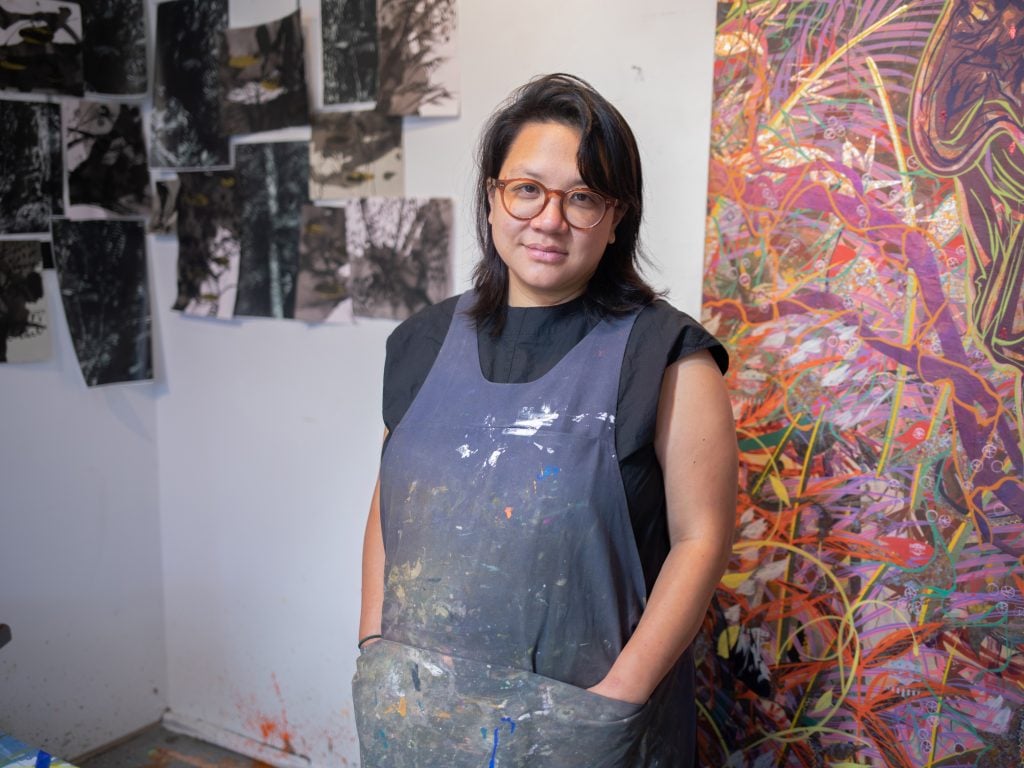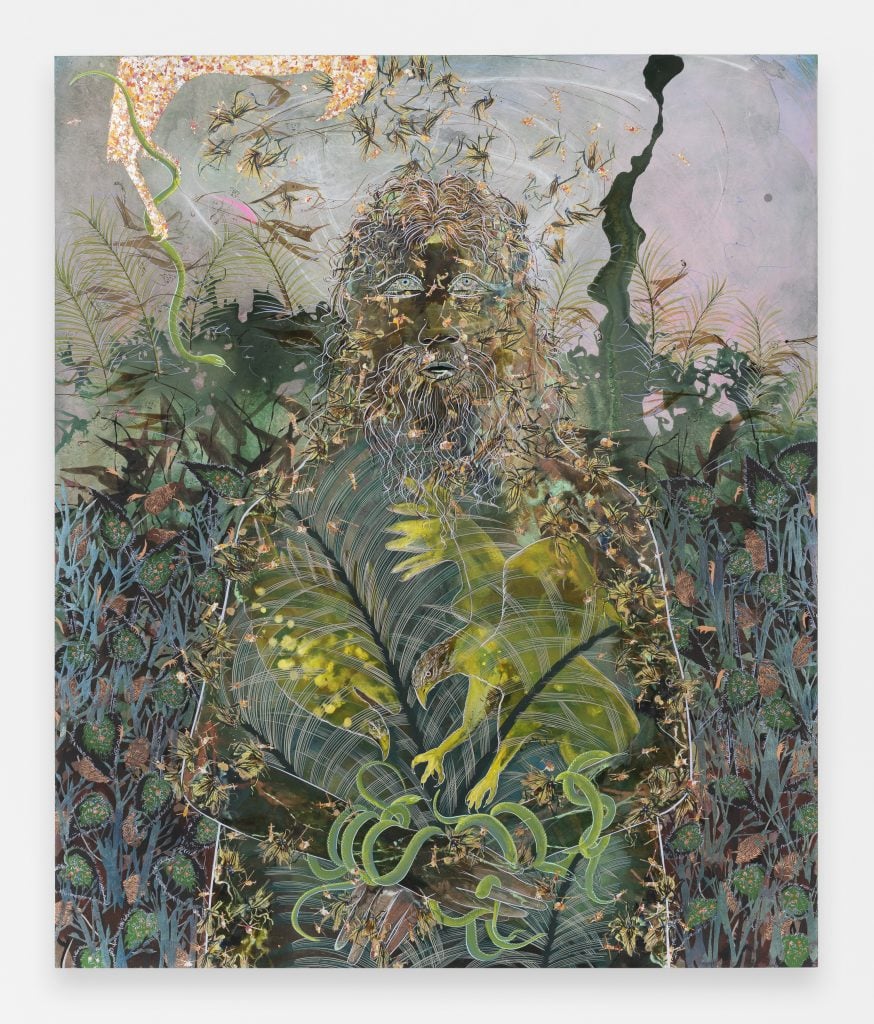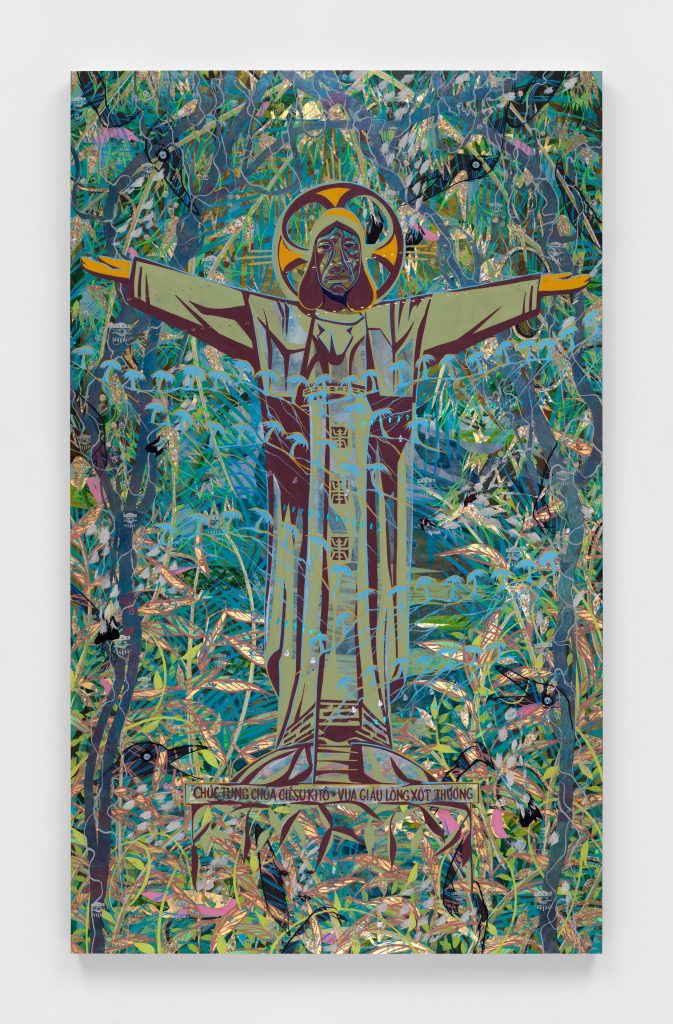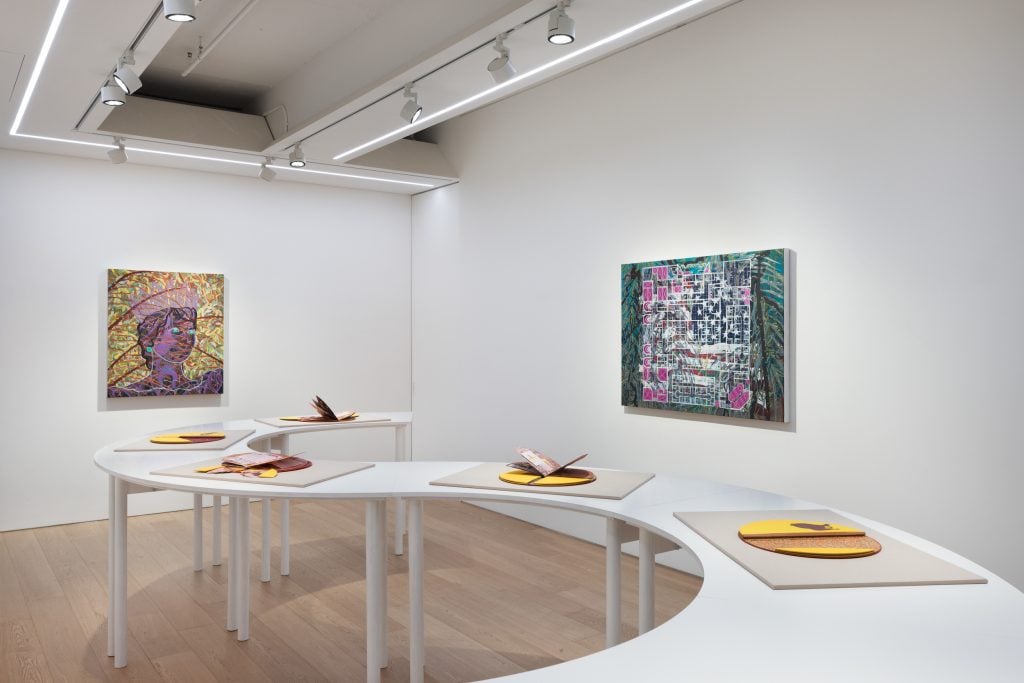Up Next
In Painter Tammy Nguyen’s Tropical Tableaux, Emersonian Transcendentalism and Modern Vietnamese History Synthesize to Stirring Effect
The artist's first solo museum show in the United States is now on view at the ICA Boston.

The artist's first solo museum show in the United States is now on view at the ICA Boston.

Annikka Olsen

“There are so many different topics and narratives and histories and mythologies that I want to dive deeply into, and I can’t do it all,” American multidisciplinary artist Tammy Nguyen said from her home base in Connecticut. “So I rely on opportunities and serendipity to find the moment to explore those things,
Fortunately for Nguyen, opportunities have seemingly abounded recently. Following on the heels of her noted presentation of 14 paintings depicting the Stations of the Cross at the Berlin Biennale, the artist is currently the subject of her first solo museum show in the United States at the ICA Boston. The eponymous exhibition traces one of Nguyen’s latest research-based deep dives and sees her engage with everything from 19th-century transcendentalism to land reform programs that were undertaken during the Vietnam War.
Nguyen was still involved with the Berlin Biennale when the ICA Boston presented her with the idea of a solo show with the institution. The Stations of the Cross series of paintings synthesized the history surrounding colonization and religion in Vietnam with imagery associated with the country’s verdant landscape rife with animal and insect life. With the works visually interpreting the 14-step Catholic devotion commemorating Jesus Christ’s last day on earth, the collection of works destabilizes ideas around how each step has or should be shown.

Tammy Nguyen, Stations of the Cross (Jesus is condemned to death) (2022). © Tammy Nguyen. Courtesy of the artist and Lehmann Maupin.
“When the ICA Boston came to me with the opportunity to do a solo exhibition, I was very much thinking about Catholicism, post-colonial imaginations, and the tropical, wild wilderness as well as human culture, human ideology,” said Nguyen.
On view through January 28, 2024, the present solo show is brimming with Nguyen’s hallmark intricately layered, lush compositions brimming with iconographic details. It also spans the breadth of her practice, including painting, works on paper, and artist books—the “trinity” of her practice: “One of the things I’m really concerned about is how ideas of language and reading lead to questions of how one reads a story or reads a narrative depending on the format the story is being put in.”
Working through ideas and research via a variety of mediums results in a body of work that inherently offers different vantage points and can in many ways meet viewers where they are. Where Nguyen’s paintings rely on a visual lexicon that can evoke and suggest certain conceptual trajectories, within her artist’s books the journey is textually laid out—offering insight that wouldn’t otherwise be easily deciphered but is nevertheless available through the dynamics of Nguyen’s multidisciplinary practice.

Tammy Nguyen, Ralph Waldo Emerson (2023). Photo: Izzy Leung. © Tammy Nguyen. Courtesy of the artist and Lehmann Maupin.
At the proverbial heart of the exhibition is Ralph Waldo Emerson’s 1836 book-length essay Nature, which the artist, like so many of us, first encountered in high school. In it, Emerson outlines the tenets of transcendentalism through the lens of nature’s usages to man. The exhibition provided the perfect opportunity to revisit and explore the texts. Visiting family in Concord, Massachusetts, where Emerson lived when he wrote his seminal text, gave Nguyen a chance to unpack the text “in situ,” if you will.
Further inspiration came from another author that Nguyen admired, Tyler Green, whose 2021 book Emerson’s Nature and the Artists: Idea as Landscape, Landscape as Idea reprints the essay alongside Green’s own appraisals and is illustrated by classic American landscape paintings and photographs.
Reflecting on her own American cultural background—namely the ethos of boot-strapping individualism—experiences, and past research drew forth a parallel investigation into the history of Vietnam, specifically the years following the Vietnam War and land reformation efforts. Early in Nguyen’s academic career, she was awarded a Fulbright Fellowship to study traditional lacquer painting in Vietnam, after which she spent several more years living and working in the country. The Southeast Asian country has remained a potent source of inspiration for Nguyen’s work.

Tammy Nguyen, Three Vietnamese Officials Study Land Reform (2023). Photo: Izzy Leung. © Tammy Nguyen. Courtesy of the artist and Lehmann Maupin.
Emerson’s treatise on transcendentalism and 1950s and ’60s land reformation efforts in Vietnam might, at first, seem completely disparate. But following Nguyen’s line of inquiry through her work, the parallels are evident—even obvious. Her ability to take seemingly incongruent ideas, histories, and narratives and break them down to their basic elements so they instead can be understood as counterparts is enviable, and in and of itself creates an opportunity to reassess and reconsider notions of perspective and understanding. “I’m always interested in taking one piece of history from one body of knowledge or common understanding, and then collapsing it with another body of narratives and histories.”
Juxtaposing Emerson with Vietnamese history saw Nguyen conducting research within the National Archives, where a series of five boxes contained portions of the records of the foreign aid projects in Vietnam, specifically land reformation endeavors. Budget sheets, zoning designations, propaganda drawings, and more collectively illustrated the Vietnamese landscape into codifiable, commodifiable parts. “That was really interesting to learn about how something as wild as the Vietnamese landscape or any landscape can be broken down to, say, the number of typewriters you need.”
Information, both textual and iconographic, gleaned from the archives, Emerson and his appraisal of nature, and a range of metaphoric and symbolic imagery populate Nguyen’s new works. Exceptionally lush, layered, and detailed, her work invites careful inspection and reading, with a visual lexicon poetically conveying the course of her meticulous research, and, ultimately, the underpinning theme of human universality. Echoes of the artist’s previous research into Catholicism and Catholic colonialism within the context of mid-20th-century Vietnam can be seen as well, such as in the large-scale depiction of Jesus Christ titled such in Vietnamese, Chúa Kitô Vua (2023).

Tammy Nguyen, Chúa Kitô Vua (2023). © Tammy Nguyen. Courtesy of the artist and Lehmann Maupin.
The artist’s indefatigable process of researching and exploring will be further expanded—though seemingly impossibly—spring of next year with the presentation of her solo show “A Comedy of Mortals: Purgatorio” with Lehmann Maupin, London. The second in a series of three solo exhibitions with the gallery, here Nguyen turns her attention to Dante’s Divine Comedy (1321), with each presentation focusing on the text’s descriptions of hell, purgatory, and heaven—but of course with the artist’s signature inclusion and juxtaposition of other histories, mythologies, and inspirations.
Discussing the first exhibition, “A Comedy for Mortals: Inferno,” held at Lehmann Maupin, Seoul, earlier this year, Nguyen said, “I took Dante and Virgil’s descent into the nine rings of hell and made an analogy to a geopolitical theater and compared the descent to and ascent into space. I used different archival materials about the space race during the Cold War.” With added elements involving Southeast Asia, the artist employed the full range of mediums at her disposal to explore the themes and their parallels, showing 13 paintings, nine works on paper, and nine artist books, allowing for different levels of engagement and varying perspectives of her work and its foundations. The exhibition series will culminate with “A Comedy for Mortals: Paradiso” in early 2025 at Lehmann Maupin, New York.

Installation view at Lehmann Maupin Seoul of “Tammy Nguyen: A Comedy for Mortals: Inferno” (2023). Photo: OnArt Studio. Courtesy of Lehmann Maupin, New York, Hong Kong, Seoul, and London.
Despite the abundance of exhibitions and projects slated, Nguyen continues her unrelenting exploration and investigation into new research and ideas. “I’ve become really interested in poems with strong structures lately, and I have a haiku project that I want to work on. Thinking a lot about this type of poetry in the making of artist books, they borrow a lot from structure poetry. That’s something that doesn’t yet have an opportunity or real deadline, but it’s something that is definitely being marinated. It’s one of these starting points, so once the opportunity presents itself it’s like the soil that it grows from.”